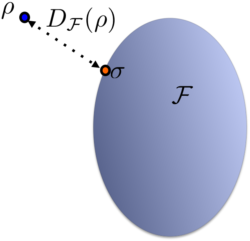Definition of the Interaction Distance
The interaction distance, , is a function of only one argument -- the interacting reduced density matrix
:

Interaction distance represents the minimum of trace distance , between
and
which belongs to the manifold of free density matrices
. Note that to obtain the final value for the interaction distance we need to perform a minimisation over all possible
. Hence, the meaning of
is the shortest distance of
from the manifold
(see Figure on the left).
is a property of a quantum state, or more precisely its reduced density matrix
for a specific bipartition of the system. For a spin chain of length
and equal bipartition, the manifold
is a
dimensional space and the variational parameter
has the same dimension as
, namely
x
. Fortunately the optimisation over
can be reduced to one with only
parameters. This crucial simplification is possible due to the following theorem in linear algebra. Assume that both
,
have been separately brought to diagonal form. Then, the minimum of trace distance between
and
, where
is any unitary matrix acting on the subsystem, is achieved when
is the permutation matrix. In other words, the minimum can be computed by knowing only the spectra of
and
, where both spectra are arranged in the same way (for example, from largest to smallest eigenvalues). This means the optimisation need only be performed over the spectrum of
, which is a much simpler optimisation over a space of dimension
.
The code section explains how the "esfactor" Python library, written by Christopher Turner, is used in order to perform the optimisation procedure and retrieve the value of and the spectrum of the optimal model,
.
